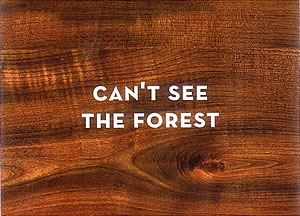
...but you can sure see the woodgrain! Card advertising January 2005 show at Sixspace Gallery, Los Angeles
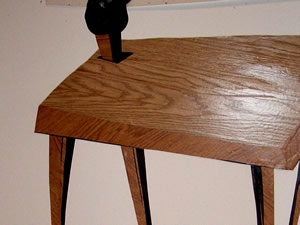
Bloody Old Head Games(2005), Wangechi Mutu, Detail of piece from recent solo show at SF MOMA. Does Wangechi Mutu know Santiago Cucullu?
Feature: Essays
Against The Grain
I’ve become known as the “Fake Woodgrain Guy.” That’s how one of the artists I interviewed for this article referred to me. Even in the absence of such a title, there are at this point many people who associate me with fake woodgrain – the simulation of wood surface, what the French call faux bois. The irony is that I have no interest in it. It’s simply that I keep coming face to face with what might be called a “Fake Woodgrain Art World.”
The first time I noticed it was the summer of ‘04, at the inaugural Supersonic survey of work coming out of the much-vaunted Southern California MFA programs. There it was, the aptly titled Woodgrain Diptych. It hung there, in the air, a non sequitur. One could only declare, Why not? Still, contextualization was forthcoming; my companion, fresh from taking in the ‘04 Whitney Biennial, Chelsea, and the rest of NYC informed me, “it’s all the rage.”
After that I started to see it everywhere; in paintings by CCA grad Eleanor Harwood, in an installation at the Hammer museum by Santiago Cucullu, in a series of pieces at the Orange County Museum of Art’s California Biennial by Kaz Oshiro, in paintings by Eamon Ore-Giron, in the latest edition of Bay Area Now... By the time I walked into that exhibition, this past summer, it had already seemed a guarantee that I would see fake woodgrain in some form at, like, every fourth gallery I set foot in. And by then, the list was hardly complete. Hey, wanna check out the show at the Luggage Store? It was there. ProArts in Oakland? Sixspace in Los Angeles? The Office in Orange County? Area 405 in Baltimore?
And not just fake woodgrain. In many cases, it’s even more specific than that. In many cases, it’s woodgrain contact paper. Cucullu used it. Brook Budner, whose fellow RISD alum curated her into the Luggage Store show, used it. Christine Tillman, currently based in Baltimore, used it. Kaz Oshiro’s claim to woodgrain fame is a collection of simulacra of ubiquitous objects associated with fake woodgrain, like stereo speakers, mini fridges, and trash receptacles. But for the Biennial show he made an alteration to the space where his work was presented: he covered a set of nearby utility closet doors with woodgrain contact paper.
Just like Gretchen Bennett in Seattle. At this point I’m going beyond work I have actually seen. There’s so much, how could I have seen it all? I didn’t see Alex Hay’s work in the ‘04 Whitney Biennial. Or Thomas Hirschhorn’s recent work in Europe. Or the 2004 series of pieces by Mike Kelly, titled – what else? – Wood Grain.
While the use of fake woodgrain in art is hardly new (Richard Artschwager practically made a career of it), what is new is how widespread it has recently become, with a profusion of artists of disparate mediums, theoretical underpinnings, and geography, all of them using the exact same element. What’s also remarkable is that, of the several artists in question with whom I have spoken, only a few of them have been aware that others have been working with fake woodgrain.
Certainly, art trends are ubiquitous; frequently they are accompanied by concurrent trends in design or fashion. Here there is no exception, as exemplified by Readymade Magazine, Sleater-Kinney’s The Woods album and attendant packaging, the AIDS Healthcare Foundation’s We Want You Back campaign, and the Isaac Mizrahi Wood Grain Dress and Wood Grain Skirt, to name just a few. But how many trends involve something so specific? One might cite “service art” as a trend that is eminently specific and readily identifiable. Artists like those in the Chicago-based collective Temporary Services come to mind, or those that Glen Helfand references in his review of the recent edition of Bay Area Now titled We Live to Serve. But it would be just as easy for a critic to point out all the ways in which any given “service artists” are doing something different from each another, and maybe not even providing a service at all. Such is the subjectivity of naming, classification, perception.
Fake woodgrain is another matter; it’s not open to interpretation. It’s either fake woodgrain or it isn’t. Like hair spray. There is a festival-cum-competition called the 48 Hour Film Project, for which each entrant makes a complete short film during the titular time period. To guard against covert preparation, the organizers announce, just before the clock starts ticking, one or two required elements. In one recent edition, for example, every film had to have a scene showcasing the use of… hair spray. No matter what the plot, at some point, zap! Out comes the aerosol can. Imagine what it would be like if, in the course of everyday movie viewing, you started noticing film after film, their makers having no connection to each other, disparate ideas underpinning them, all featuring the demonstrative, gratuitous inclusion of hair spray.
Perhaps I have earned my distinction as “the fake woodgrain guy” because I am one of the only people I know who regards the current profusion of fake woodgrain in art as evidence of – here, I’ll say it – lack of originality. The counter argument is either that I have not shown it to be a “profusion” at all or that to speak of “originality” is naive, or both. For the former, leaving aside that the examples I have offered represent just a sample, I would think that anyone with an investment in the notion of art as province of originality and individuality would find even a few instances of artists all using such a specific element as remarkable. As for that notion, it can indeed be said that the collision of the original, the authentic, the individual, with the imitation, the ersatz, the copy is a tension, a dialectic, which hangs over, or informs, art. Certainly, Duchamp’s readymades are but one touchstone. To come down as a “believer” in one side or the other would be a misguided attempt to “fix” what can never be stabilized. Nevertheless, this is precisely the way in which the field of art functions. Artforum’s “Best of 2005” is not a list of trends, but people. We credit Duchamp as an individual who originated or authored the problematizing of origination and authorship. When I asked one of the woodgrain artists if she was aware of being part of a trend, she quipped, not missing a beat, “Oh! Well, I started it!” Glen Helfand, in the aforementioned review of Bay Area Now, writes:
“Artists, in myth and in truth, are of maverick, individualistic stock. To make art means to think differently, to face misunderstanding. Artists are still outsiders who frequently work alone and in isolation”
How differently are all these artists thinking from each other? And how different is art from anything else, when one can see the familiar word Helfand uses to describe artists, maverick, emblazoned on a recently opened San Francisco restaurant, whose advertising ironically features woodgrain? Maybe it’s not that people do not have an investment in the ethos Helfand’s articulation of which is but one of many, but precisely that they do, that has made them ignore the significance of the fake woodgrain trend, or seeing it as a trend at all. If so, what would they make of the various rationales several of the artists I spoke with offered for their use of the material? “Nature has always influenced art”... “it’s something to do with the Mission School”... “It’s all around us, so I use it in my work”... This does not sound like the thinking of originators. It sounds rather like the voice of a conduit, a medium for what is in the cultural ether.
What is ironic is that, however unconscious of it many of these artists may be, it is precisely an ambivalence about the agency of the artist and the validity of aesthetic choices that seems to underlie this work. While it struck me that both Budner and Oshiro said they were deliberately choosing to use something ugly, that begs the question of how that something ended up being fake woodgrain. Which leads to Oshiro’s and Tillman’s observations about the veneer’s connection to class. Once upon a time, fake woodgrain, though not technically considered trompe l’oeil, nevertheless “tricked” complicit middle class consumers into believing they were aristocratic enough to own the kind of furniture that was in reality out of their reach. And so fake woodgrain has, for contemporary artists who grew up with it, the distinction of being at once tinged with the warm glow of nostalgia and simultaneously visible with hindsight and the vagaries of fashion as déclassé. As such its widespread use can be seen as not simply a wrestling with aesthetics; fake woodgrain is innocence lost.
And if you’re not inclined to look down on fake woodgrain as ugly and/or associate it with the security and innocence of childhood, and thus, like me, you find its use in so much of this work to be arbitrary, gratuitous, then so much the better. Fake woodgrain is no less a sign for the gratuitous; so ubiquitous has it become, it is a veritable floating signifier. “It’s all around us,” indeed. Here again, it seems impossible to avoid that these artists are grappling and playing with the meaningfulness or value of art and the agency of the artist. That fake woodgrain is no less widespread at this moment in fashion and design, and that the motivation for its use in art appears to be largely unconscious – once again, so much the better.
Finally, fake woodgrain is perhaps most significantly a sign for, well, the fake – the imitation, the simulacrum. These artists are not trying to be different, original – from each other or anything else. Whether they are capable of doing so is beside the point; on some level they do not appear to believe it is even possible anymore, if it ever was. The discourse of art is maybe one of the last “origin stories” our culture has, so perhaps it is only natural that the ultimate sign for the ersatz, the inauthentic, should be proliferating wildly, as a kind of antidote. Innocence lost indeed. Maybe that is why woodgrain contact paper seems like such a good choice to so many of the woodgrain artists, it being not just an imitation, but an imitation of a veneer. And, as I have observed, if using this signifier for the simulacrum, in the form of contact paper or otherwise, is so ubiquitous as to seem derivative, it is made doubly unoriginal by virtue of having been famously explored by the likes of Jean Baudrillard decades ago. Irony upon irony.
That’s just the thing. I was trying to get to a different place from where I started. My inclination has been to be against the grain, precisely because artists are supposed to be against the grain, but I wanted to try to figure out what might be going on beneath the, uh, surface. What it looks like at this point is not so much that it’s lazy for these artists all to be using fake woodgrain; it’s lazy for them to be relying on the tired ironic pose, the hipster smug shrug, itself a kind of veneer. Aren’t the 90’s over? Rather than leave it at that, and risk modeling the kind of glibness that I am critiquing, I’ll say: maybe what is “so over” is an abiding faith in art to be anything other than arbitrary, gratuitous, ersatz.
Whatever one might conclude about this trend, this phenomenon, whatever it might represent, one thing is clear: fake woodgrain has become a signifier for nothing less than art itself. The Supersonic showcase of SoCal MFA work appears to be firmly established, with the third edition planned for this summer. I didn’t make it to this last installment, but I did happen to see the brochure. Naturally, its use came with a rationale – as with any of the instances I’ve mentioned – but there it was, nevertheless, the single piece of imagery on the brochure, representing this major art market’s next wave – fake woodgrain.
(2) COMMENTS
my heart goes out to you.
this “art” world you describe seems so grim in its irony-laden state.
lately, for myself, I’ve been trying to operate with some sort of equation like: (thought plus action) times joy [as in genuine spiritual elevation] equals art, and all the better if you can share it with someone.
alot of the work you describe sounds like it’s made by people who think art should be about holding up a mirror to what they perceive as an epidemic of ugliness in the world so we can all take a good look at it. Oh, my, how terribly confrontational of them (he typed with bitchy malice in his heart).
to them I say - tell me something I don’t already know.

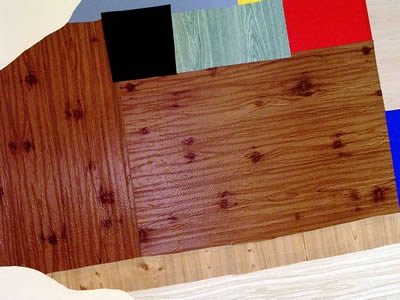
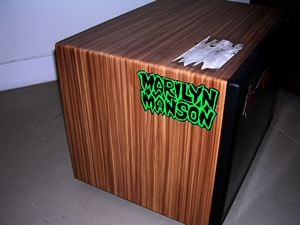
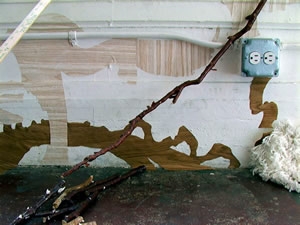

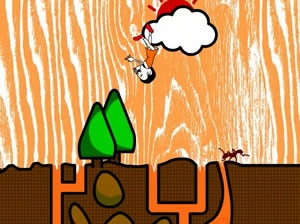
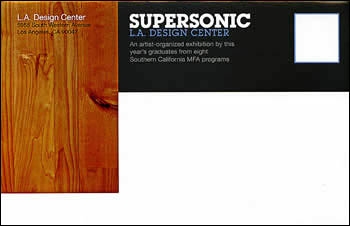
I think that it’s all part of a larger discomfort with and search for authenticity by detouring through irony. In fashion, that means trucker hats, in design, deconstructed moose heads and the use of antique lace patterns. I’m not sure whether it’s the artists/designers/consumers expecting to mock those who take these symbols at face value, or whether it’s a genuine grasping for something authentic without wanting to expose their own romanticism. (it’s probably both) As LCD Soundsystem says, maybe they want to make something real, like a Yaz record.
Mike • April 13, 2006